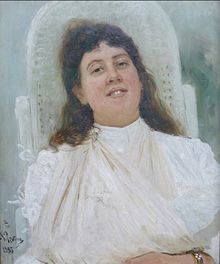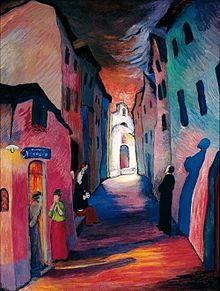Portrait of Marianne Werefkin

Portrait of Marianne Werefkin is the title of a portrait that Ilya Jefimowitsch Repin painted in 1888 by the Russian artist Marianne von Werefkin . It was formerly part of the inventory of her studio house on her family's estate in Lithuania , which has been preserved just a few kilometers northwest of the provincial town of Utena . Werefkin bequeathed the picture to Ernst Alfred Aye . In 1958 it was acquired by the then museum director Clemens Weiler in the art trade for the Wiesbaden Museum . It bears the inventory number M 766.

Technology, dimensions and labeling
It is an oil painting on canvas . The dimensions of the portrait format are 60 × 51 cm. The signature reads in Cyrillic : “I. Rjepin ". For a long time the painting was incorrectly dated “1885”. On closer inspection, the date could be reliably identified as "10.12 1888".
Image description
Repin chose the chest piece as the picture format to portray the dark-haired Werefkin. She sits on a chair, the back of which is covered with rattan and the top of which ends in a semicircle. This looks like a nimbus over the Werefkin's head - certainly intended by Repin . The painting was created after a hunting accident that Werefkin suffered in his parents' “Posoli Forest” in Lithuania. While resting they had "clumsily" in the course of her with shotgun loaded shotgun supported. The skirt tangled when the rifle cock moved , triggering the shot that nearly killed her and crippled her right hand forever. That happened in November 1888.
Repin was shocked when he heard about the accident. The Werefkin's artistic career seemed to be over to him. Werefkin's thumb and forefinger remained immobile forever, even though she practiced with infinite perseverance. After initial attempts with her left hand, she decided to paint with her right hand again in 1889. With her left, healthy hand she then placed a pencil, brush or charcoal over the ring finger of her crippled right hand in order to grasp and guide the tool with her middle finger and little finger. In the future, she was forced to provide her painting tools, regardless of whether they were pens or brushes, with small holders in a special way so that they could not slip away from her while she was working. The unusual handling of pencil and brush often caused her not only pain, but also resulted in the fact that the tense position of the painting tools kept developing a thick callus on both of her healthy fingers. If Werefkin felt unobserved, she removed them with a knife that she always had with her.
Characterization in light and white colors
During the recovery process, Repin portrayed the patient. Photos seem to have served him as a template. The comparison with the painting shows a difference. The posture and facial expression of the young woman in the photo shows the side effects of the illness and the depression of the fatal accident. Repin, on the other hand, depicts in his painting those striking, life-affirming traits that he and other friends usually found in the baroness. Repin depicted Werefkin exclusively in light and white colors. He designed the picture so vividly that the impression is created that she is sitting, rocking back and forth, in a rocking chair and could jump up at any moment to loosen her arm and hand from the bandage as if the injury was just a harmless ghost. "Head posture, gaze and facial expressions are very typical for the Baroness. Being a little thoughtful, she smiles at the viewer and fixes him with a look as if she were up to a joke." With his painting, Repin represented exactly those traits of the Werefkin which prompted the poet Else Lasker-Schüler to call the baroness “the aristocratic street boy”, who was known as the “rogue of the Russian city; leased every prank in a wide area ”.
literature
- Bernd Fäthke : Marianne Werefkin, paintings and sketches. Exhibition catalog Museum Wiesbaden 1980.
- Bernd Fäthke: Marianne Werefkin, life and work. Munich 1988.
- Bernd Fäthke: Marianne Werefkin. Munich 2001.
- Brigitte Roßbeck: Marianne von Werefkin. The Russian from the Blue Rider's circle. Munich 2010.
Individual evidence
- ↑ Clemens Weiler (ed.): Marianne Werefkin, letters to an unknown 1901–1905. Cologne 1960, p. 55; Ulrich Schmidt: Repin, Ilja. In: Städt. Museum Wiesbaden, picture gallery. Catalog, Wiesbaden 1967, n.p.?.
- ↑ Bernd Fäthke: Marianne Werefkin and her influence on the Blue Rider. In: Exhibition catalog Marianne Werefkin, paintings and sketches. Museum Wiesbaden 1980, p. 16.
- ↑ The proof is the picture
- ↑ Bernd Fäthke: Securing evidence for the Blue Rider in Lithuania. 6. Announcement from the Association of Berlin Artists V., Berlin 1995, n.p., ill.p.7.
- ↑ Bernd Fäthke: Marianne Werefkin . Munich 2001, p. 28.
- ↑ Brigitte Roßbeck: Marianne von Werefkin, The Russian woman from the circle of the Blue Rider. Munich 2010, p. 40.
- ^ Elisabeth Erdmann-Macke: Memories of August Macke. Frankfurt 1987, p. 240.
- ↑ Bernd Fäthke: Marianne Werefkin . Munich 2001, p. 29.
- ↑ Bernd Fäthke: Marianne Werefkin - "the blue rider". in the exhibition catalog Marianne Werefkin: From the Blue Rider to the Great Bear. Städtische Galerie Bietigheim-Bissingen 2014, p. 56, fig. 64 and 65.
- ↑ Since the painting is dated December 10th, 1888, it can be assumed that it was a Christmas present from Repin for Werefkin.
- ↑ Bernd Fäthke: Marianne Werefkin, life and work. Munich 1988, p. 29, fig. 23 and 24.
- ↑ Brigitte Roßbeck: Marianne von Werefkin, The Russian woman from the circle of the Blue Rider. Munich 2010, p. 41 f.
- ↑ Bernd Fäthke, Marianne Werefkin, Munich 2001, p. 30.
- ↑ Else Lasker-Schüler: Marianne von Werefkin, Complete Poems. Munich 1966, p. 223 f.